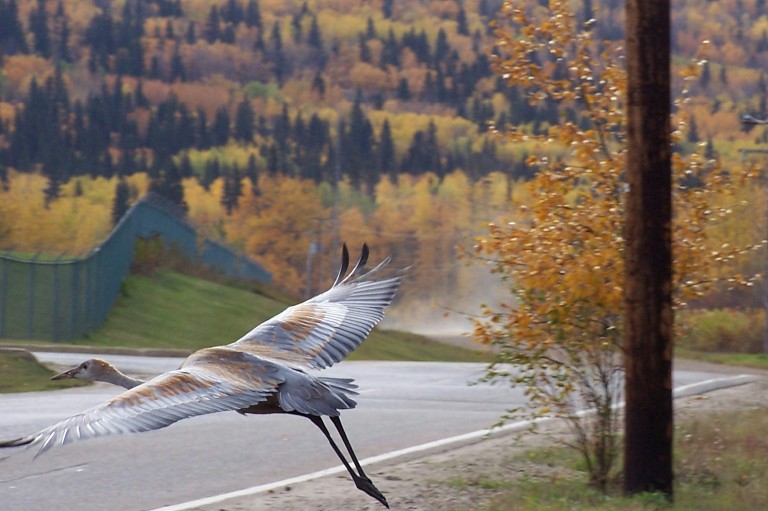Tourism
Discover the Bird-Watching Paradise of Fort McMurray Wood Buffalo, Alberta
Bird-lovers, this is your guide for FMWB
If you're a bird-watching enthusiast or simply love nature, Fort McMurray Wood Buffalo, Alberta, is a must-visit destination. This region, particularly within Wood Buffalo National Park, is home to an incredible diversity of bird species. Here are some of the most notable birds you can spot, making your bird-watching adventure truly unforgettable.

Whooping Crane: One of the rarest birds in North America, the whooping crane is a significant conservation success story. Wood Buffalo National Park is the only natural nesting site for this endangered species. Seeing these majestic birds in their natural habitat is a once-in-a-lifetime experience.
Trumpeter Swan: The largest native North American bird, the trumpeter swan, can be found in the wetlands of northeastern Alberta. These majestic birds are known for their impressive wingspan and distinctive trumpet-like calls. Their graceful presence is a highlight for any bird-watcher.
Peregrine Falcon: Known for its incredible speed, the peregrine falcon is a top predator in the region. Often seen hunting in open areas and along river valleys, this bird's aerial acrobatics are a sight to behold.
Great Horned Owl: Alberta's provincial bird, the great horned owl, is a common sight in the boreal forests of northeastern Alberta. This powerful nocturnal predator is known for its distinctive ear tufts and deep hooting calls. Spotting one of these owls is always a thrill.
American White Pelican: These large, white waterbirds with black wingtips are often seen in the region's lakes and rivers. Known for their cooperative fishing techniques and impressive migratory journeys, they are a fascinating species to observe.
Bald Eagle: A symbol of strength and freedom, the bald eagle is frequently spotted near large bodies of water where it hunts for fish. Its striking white head and tail make it easily recognizable and a favorite among bird-watchers.
 Sandhill Crane: These tall, gray birds with red crowns are known for their distinctive bugling calls and elaborate courtship dances. They are often seen in wetlands and open fields, adding a touch of elegance to the landscape.
Sandhill Crane: These tall, gray birds with red crowns are known for their distinctive bugling calls and elaborate courtship dances. They are often seen in wetlands and open fields, adding a touch of elegance to the landscape.
Black-billed Magpie: A highly adaptable bird, the black-billed magpie is common in both urban and rural areas. Its iridescent blue plumage and long tail make it a striking sight.
American Redstart: This small, colorful warbler is known for its striking black and orange plumage. Commonly found in the forests of Wood Buffalo National Park, it adds a splash of color to your bird-watching experience.
Black-and-white Warbler: With bold black and white stripes, the black-and-white warbler is often seen creeping along tree trunks and branches in search of insects. Its unique foraging behavior makes it a fun bird to watch.
Cape May Warbler: Recognized by its yellow throat and chestnut cheek patch, the Cape May warbler frequents the boreal forests during its migration. Its vibrant colors are a delight to spot.
Northern Flicker: A type of woodpecker, the northern flicker is known for its spotted plumage and distinctive call. Often seen foraging on the ground for ants and beetles, it’s a unique addition to your bird-watching list.
Common Loon: Famous for its haunting calls, the common loon is often found on lakes and large ponds. Its striking black and white plumage and red eyes make it easily identifiable and a favorite among bird-watchers.
Yellow Warbler: This bright yellow songbird is a common sight in wetlands and riparian areas. Its cheerful song is a hallmark of spring and summer, bringing joy to any bird-watching outing.
Osprey: Known as the "fish hawk," the osprey is often seen diving into water to catch fish. It nests near lakes and rivers throughout the region, providing exciting viewing opportunities.
Eastern Phoebe: This small flycatcher is known for its distinctive tail-wagging behavior and simple, repetitive song. It often nests on buildings and bridges, making it a familiar sight.
Red-winged Blackbird: Easily recognizable by the red and yellow shoulder patches on males, the red-winged blackbird is commonly found in marshes and wetlands. Its striking appearance and loud calls make it a standout species.
Barn Swallow: With its deeply forked tail and agile flight, the barn swallow is a familiar sight around open fields and farms. It builds mud nests on structures, adding charm to rural landscapes.
Ruby-throated Hummingbird: This tiny bird is known for its iridescent green plumage and ruby-red throat. It frequents gardens and feeders during the summer months, delighting observers with its rapid movements.
Northern Shrike: A predatory songbird, the northern shrike is known for impaling its prey on thorns or barbed wire. It can be seen in open areas and forest edges, adding a touch of drama to your bird-watching experience.
These bird species contribute to the rich biodiversity of northeastern Alberta and offer excellent opportunities for birdwatching and wildlife photography. Whether you're a seasoned birder or a casual nature enthusiast, the region's avian life is sure to impress.
So pack your binoculars, grab your field guide, and head to Wood Buffalo, Alberta, for an unforgettable bird-watching adventure. Happy birding!

